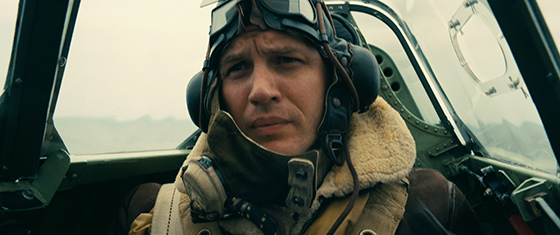Dunkirk

TOM HARDY as Farrier in the Warner Bros. Pictures action thriller "DUNKIRK," a Warner Bros. Pictures release. Photo Credit: Melinda Sue Gordon

There’s a scene in Christopher Nolan’s INTERSTELLAR where a distant wave on an exoplanet crests hundreds of feet above sea level. The tension of this moment builds and builds until the crewed shuttle makes their narrow escape. DUNKIRK begins at that crest, followed by another, and another, and another, each more terrifying than the last. It plays like a visual translation of Holst’s “Mars: The Bringer of War”.
Brusque in my dismissals of Nolan’s past work, I see a director evolving. With MEMENTO (2000) I had yet to be convinced that the backward chronology was more than a gimmick to conceal an otherwise mundane narrative. In THE DARK KNIGHT (2008) and INCEPTION (2010), Nolan’s successes gave way to excesses of action and incoherent editing to further conceal an apparent distaste for cogent narratives. Credit where credit is due, the man knew how to shoot a scene. He just didn’t know how to connect them together properly.
Two films, THE PRESTIGE (2006) and INTERSTELLAR (2014), are exceptions in his oeuvre. In the former, Nolan created a compelling, Dickensian noir about two rival illusionists, each grasping at immortality–metaphorical and literal. In the latter, Nolan scored a massive international success with a drama of familial bonds disguised as science fiction paradox.
The same man who spun his grandiose ideas out of control just four years earlier told a relatable yet philosophical father-daughter story about the cosmic permanence of love. I could even forgive the soppy dialogues, irrational female scientist, and Matt Damon, as my own beloved Ophelia¹ sat, rapt, for the last twenty-five minutes as Cooper (Matthew McConaughey) conquered space and time to return to his daughter, Murph (Mackenzie Foy).
Enter Nolan’s tenth feature. In 1940 at the Battle of Dunkirk, 68,000 British and 48,000 French lives were lost. Another 330,000 survived because of a plan enabled by the Wehrmacht’s so-called Halt Order, giving Allied forces three days to stage Operation Dynamo—a massive evacuation.
Reportedly, Nolan and his wife, producer Emma Thomas, started writing the story after traversing the English channel by boat, learning about the historic defeat on the shores of France. He spent the last twenty-five years polishing and paring down that script to just seventy-five pages of slug lines and sparse, almost nonexistent dialogue.
DUNKIRK, shot in a combination of IMAX and Panavision 65mm, dramatizes the battle in a triptych on land, sea, and in the air. The film opens on five soldiers, including Tommy (Fionn Whitehead), barely surviving a shelling in the city. Their commanding officer dead, they scramble aimlessly across the Maginot line until one reaches the shore where thousands of troops are being evacuated on destroyers and medical frigates, many carried out on stretchers.
From here, the three perspectives are intercut: 1. Tommy attempts to board a doomed frigate. 2. Mr. Dawson (Mark Rylance) and his son join other affluent civilians on yachts, enroute to aid in the massive evacuation. 3. RAF Pilot Farrier³ (Tom Hardy) and his wingmen give air cover to the evacuees.
If Hoyte van Hoytema’s visual story interprets Holst, apropos that Hans Zimmer’s score steers clear of the kind of cacophonous bombast that Spielberg might commission from John Williams. Instead, his amorphous swell rises sparingly, precisely when it must. The effect is like the atonal, orchestral crescendos in The Beatles “A Day in the Life”—the Shepard tone. Then, he rests us gently back down, like Farrier’s plane coming ashore, in the arms of a new derivative of Elgar’s “Nimrod” from the Enigma Variations.
And it’s just like that. Amidst the crests and troughs of the battle sequences, the images tell us of the Dawsons’ war-hardened shrewdness and personal tragedies; of Farrier’s unflinching trust in his wingmen as he takes down five², perhaps six, Messerschmitt Me-109’s in his Supermarine Spitfire with its roaring, Rolls Royce Merlin engine; and Tommy’s epiphany as an elderly man hands him a blanket. His shipmate, Alex (Harry Styles) remarks snidely, “All we did was survive.”
The man, a veteran likely blinded during the Great War, replies, “That’s enough.”
There’ll be endless editorials about the 70mm film shoots, in-camera/practical fx, the live extras, the real planes and ships, but DUNKIRK’s triumph owes to the simplicity of the finished product, not the complexity of the technical inputs. That masterful distillation is the piece that Nolan has finally brought under his command.
Footnote: The AMC IMAX where they screened the film made an absolute mess of the sound, which I expected. I suspect that the 70mm presentation I’m seeing this weekend at LOOK Cinemas Prestonwood will be much more tightly managed.
- Ophelia is a dog. She loves watching science fiction with daddy.
- This is perhaps based on the feat of 605th RAF Squadron Leader Archibald “Archie” McKellar, who shot down five Bf-109’s in a day during the Battle of Britain.
- The British surname Farrier is of French origin vis-à-vis the Norman conquest of 1066. While it means “blacksmith”, its root is the French word for iron—indicating perhaps an “iron-haired” (silver-haired) or, more likely in this case, iron-willed, ancestor.